Capacitively Coupled CSRR and H-Slot UHF RFID Antenna for Wireless Glucose Concentration Monitoring
Abstract
1. Introduction
2. Design Concept and Modeling
2.1. Dielectric Modeling of Glucose Solutions
2.2. Equivalent Circuit Model
3. Sensor Design and Simulation
3.1. Antenna and Resonator Geometry
3.1.1. H-Slot Antenna
3.1.2. Circular CSRR
3.2. Simulation Setup
3.3. Simulation Results
3.3.1. Antenna Impedance
3.3.2. Electric Field Distribution
3.3.3. Glucose Sensing Response
4. Fabrication and Measurements
4.1. Fabrication Process
4.2. Experimental Setup
4.3. Glucose Measurements
4.3.1. Threshold Power Analysis
4.3.2. Read Range Analysis
5. Discussion and Future Work
6. Conclusions
Author Contributions
Funding
Institutional Review Board Statement
Informed Consent Statement
Data Availability Statement
Conflicts of Interest
References
- Korostynska, O.; Mason, A.; Al-Shamma’a, A. Microwave sensors for the non-invasive monitoring of industrial and medical applications. Sens. Rev. 2014, 34, 182–191. [Google Scholar] [CrossRef]
- Song, X.; Vandenbosch, G.A.; Yan, S. An Enhanced Microwave Differential Microfluidic Sensing System for Detecting Small Variation of Dielectric Properties. IEEE Sens. J. 2025, 25, 9608–9617. [Google Scholar] [CrossRef]
- Trabelsi, S.; Nelson, S.O. Microwave sensing of quality attributes of agricultural and food products. IEEE Instrum. Meas. Mag. 2016, 19, 36–41. [Google Scholar] [CrossRef]
- Martín, F.; Vélez, P.; Muñoz-Enano, J.; Su, L. Planar Microwave Sensors; John Wiley & Sons: Hoboken, NJ, USA, 2022. [Google Scholar]
- Leelatien, P.; Prempraneerach, P. Microwave planar resonator-based sensor for pharmaceutical tablet-moisture characterization based on complementary symmetric meander line-shaped structure. Aust. J. Electr. Electron. Eng. 2024, 22, 482–490. [Google Scholar] [CrossRef]
- Ali, M.A.; Islam, M.A.; Islam, M.T.; Faruque, M.R.I. Simultaneous measurement of thickness and permittivity using microwave resonator-based planar sensor. Int. J. RF Microw. Comput.-Aided Eng. 2021, 31, e22794. [Google Scholar] [CrossRef]
- Wang, Y.K.; Shi, B.W.; Zhao, J.M.; Wang, Y.X.; Jiang, Y.F.; Yang, G.L.; Gao, X.D.; Qiang, T. Highly Sensitive and Linear Resonator-Based Biosensor for White Blood Cell Counting: Feasible Measurement Method and Intrinsic Mechanism Exploration. Biosensors 2024, 14, 180. [Google Scholar] [CrossRef]
- Masrakin, K.; Ibrahim, S.Z.; Rahim, H.A.; Azemi, S.N.; Soh, P.J.; Tantiviwat, S. Microstrip sensor based on ring resonator coupled with double square split ring resonator for solid material permittivity characterization. Micromachines 2023, 14, 790. [Google Scholar] [CrossRef]
- Chuma, E.L.; Iano, Y.; Fontgalland, G.; Roger, L.L.B. Microwave sensor for liquid dielectric characterization based on metamaterial complementary split ring resonator. IEEE Sens. J. 2018, 18, 9978–9983. [Google Scholar] [CrossRef]
- Ma, J.; Tang, J.; Wang, K.; Guo, L.; Gong, Y.; Wang, S. Complex permittivity characterization of liquid samples based on a split ring resonator (SRR). Sensors 2021, 21, 3385. [Google Scholar] [CrossRef]
- Ebrahimi, A.; Scott, J.; Ghorbani, K. Microwave reflective biosensor for glucose level detection in aqueous solutions. Sens. Actuators A Phys. 2020, 301, 111662. [Google Scholar] [CrossRef]
- Abir, M.A.I.; Ahmed, S.; Alam, M.S.; Islam, M.A. Application of a complementary split ring resonator based biosensor for detection of micromolar glucose concentrations in aqueous solution. In Proceedings of the 2020 11th International Conference on Electrical and Computer Engineering (ICECE), Dhaka, Bangladesh, 17–19 December 2020; pp. 153–156. [Google Scholar]
- Ibnath, A.; Rimu, R.S.; Ullah, M.A. Dual Ring Complementary Split Ring Resonator (DR-CSRR) Sensor For Non-invasive Glucose Sensing Application. In Proceedings of the 2020 11th International Conference on Electrical and Computer Engineering (ICECE), Dhaka, Bangladesh, 17–19 December 2020; pp. 407–410. [Google Scholar]
- Omer, A.E.; Shaker, G.; Safavi-Naeini, S.; Alquié, G.; Deshours, F.; Kokabi, H. Triple-Poles Complementary Split Ring Resonator for Sensing Diabetics Glucose Levels at cm-Band. arXiv 2019, arXiv:1908.07407. [Google Scholar] [CrossRef]
- Tlili, B.; Rishani, N.R.; Malaeb, M. Non Invasive Glucose Detection Using a Triple-Pole CSRR Sensor. In Proceedings of the 2023 IEEE Conference on Antenna Measurements and Applications (CAMA), Genoa, Italy, 15–17 November 2023; pp. 663–665. [Google Scholar]
- Omer, A.E.; Shaker, G.; Safavi-Naeini, S.; Kokabi, H.; Alquié, G.; Deshours, F. Compact honey-cell CSRR-based microwave newline biosensor for monitoring glucose levels. In Proceedings of the 2020 14th European Conference on Antennas and Propagation (EuCAP), Copenhagen, Denmark, 15–20 March 2020; pp. 1–5. [Google Scholar]
- Mansour, E.; Ahmed, M.I.; Allam, A.; Pokharel, R.K.; Abdel-Rahman, A.B. A Novel Biosensor for Non-Invasive Blood Glucose Measurement Based on Double Square Complimentary Split Ring Resonator. In Proceedings of the 2023 17th European Conference on Antennas and Propagation (EuCAP), Florence, Italy, 26–31 March 2023; pp. 1–5. [Google Scholar]
- Tlili, B.; Keshkar, M. Hexa Cell Triangular CSRR for the Non Invasive Detection of Blood Glucose. In Proceedings of the 2024 International Microwave and Antenna Symposium (IMAS), Marrakech, Morocco, 21–24 October 2024; pp. 1–6. [Google Scholar]
- Harnsoongnoen, S.; Buranrat, B. Advances in a microwave sensor-type interdigital capacitor with a hexagonal complementary split-ring resonator for glucose level measurement. Chemosensors 2023, 11, 257. [Google Scholar] [CrossRef]
- Elsibaie, S.S.; Eldamak, A.R.; Elsheakh, D.N. Multiband Complementary Split Ring Resonators For Non-Invasive Glucose Monitoring. In Proceedings of the 2024 41st National Radio Science Conference (NRSC), New Damietta, Egypt, 16–18 April 2024; Volume 1, pp. 43–50. [Google Scholar]
- Yang, S.; Gao, S.; Zhuang, Y.; Hu, W.; Zhao, J.; Yi, Z. Non-Destructive Sensor for Glucose Solution Concentration Detection Using Electromagnetic Technology. Micromachines 2024, 15, 758. [Google Scholar] [CrossRef]
- Rattan, P.; Houngkamhang, N.; Orankitanun, T.; Phasukkit, P. Metamaterial Microwave Sensor for Glucose Level Measurement Based on Strip Line with Complementary Split Ring Resonator. Phys. Status Solidi (A) 2024, 222, 2400180. [Google Scholar] [CrossRef]
- Jang, C.; Park, J.K.; Lee, H.J.; Yun, G.H.; Yook, J.G. Temperature corrected fluidic glucose sensor based on microwave resonator. Sensors 2018, 18, 3850. [Google Scholar] [CrossRef] [PubMed]
- Jang, C.; Park, J.K.; Lee, H.J.; Yun, G.H.; Yook, J.G. Non-invasive fluidic glucose detection based on dual microwave complementary split ring resonators with a switching circuit for environmental effect elimination. IEEE Sens. J. 2020, 20, 8520–8527. [Google Scholar] [CrossRef]
- Haq, T.U.; Ruan, C.; Zhang, X.; Ullah, S.; Fahad, A.K.; He, W. Extremely Sensitive Microwave Sensor for Evaluation of Dielectric Characteristics of Low-Permittivity Materials. Sensors 2020, 20, 1916. [Google Scholar] [CrossRef] [PubMed]
- Su, L.; Muñoz-Enano, J.; Vélez, P.; Gil-Barba, M.; Casacuberta, P.; Martin, F. Highly Sensitive Reflective-Mode Phase-Variation Permittivity Sensor Based on a Coplanar Waveguide Terminated With an Open Complementary Split Ring Resonator (OCSRR). IEEE Access 2021, 9, 27928–27944. [Google Scholar] [CrossRef]
- Samad, A.; Islam, M.A.; Islam, M.T.; Faruque, M.R.I. High-Precision Complementary Metamaterial Sensor Using Slotted Microstrip Transmission Line. J. Sens. 2021, 2021, 8888187. [Google Scholar] [CrossRef]
- Hosseinzadeh, S.; Pakvarjouy, M. Microwave-based single port glucose sensor arranging interdigital and complementary split ring resonator. Measurement 2025, 246, 116695. [Google Scholar] [CrossRef]
- Wiltshire, B.D.; Zarifi, T.; Zarifi, M.H. Passive split ring resonator tag configuration for RFID-based wireless permittivity sensing. IEEE Sens. J. 2019, 20, 1904–1911. [Google Scholar] [CrossRef]
- Omer, A.E.; Shaker, G.; Safavi-Naeini, S. Portable radar-driven microwave sensor for intermittent glucose levels monitoring. IEEE Sens. Lett. 2020, 4, 3500604. [Google Scholar] [CrossRef]
- Raj, S.; Tripathi, S.; Upadhyay, G.; Tripathi, S.S.; Tripathi, V.S. An electromagnetic band gap-based complementary split ring resonator loaded patch antenna for glucose level measurement. IEEE Sens. J. 2021, 21, 22679–22687. [Google Scholar] [CrossRef]
- Xie, H.; Wu, W.J.; Zhao, W.S.; Wang, W. A Differential Microwave Sensor Based on Modified High-Sensitivity Substrate Integrated Waveguide (SIW) for Detecting Glucose Concentration in Aqueous Solution. IEEE Sens. J. 2025, 25, 16998–17010. [Google Scholar] [CrossRef]
- Costa, F.; Genovesi, S.; Borgese, M.; Michel, A.; Dicandia, F.A.; Manara, G. A review of RFID sensors, the new frontier of internet of things. Sensors 2021, 21, 3138. [Google Scholar] [CrossRef]
- Song, C.; Wu, Z.; Gray, J.; Meng, Z. An rfid-powered multisensing fusion industrial iot system for food quality assessment and sensing. IEEE Trans. Ind. Inform. 2023, 20, 337–348. [Google Scholar] [CrossRef]
- Amendola, S.; Occhiuzzi, C.; Ajovalasit, A.; Sabatino, M.; Dispenza, C.; Marrocco, G. Dielectric characterization of biocompatible hydrogels for application to epidermal RFID devices. In Proceedings of the 2015 European Microwave Conference (EuMC), Paris, France, 7–10 September 2015; pp. 379–382. [Google Scholar]
- Chen, X.; He, H.; Khan, Z.; Sydänheimo, L.; Ukkonen, L.; Virkki, J. Textile-based batteryless moisture sensor. IEEE Antennas Wirel. Propag. Lett. 2019, 19, 198–202. [Google Scholar] [CrossRef]
- López-Soriano, S.; Brunet, P.; Alsultan, M.; Meliá-Seguí, J. Remote Identification of Liquids Using Absorbent Materials: A Passive UHF RFID-Based Method. IEEE Sens. J. 2025, 25, 7301–7309. [Google Scholar] [CrossRef]
- Luo, C.; Gil, I.; Fernandez-Garcia, R. Textile UHF-RFID antenna sensor for measurements of sucrose solutions in different levels of concentration. Meas. Sci. Technol. 2021, 32, 105112. [Google Scholar] [CrossRef]
- Xie, S.; Ma, C.; Feng, R.; Xiang, X.; Jiang, P. Wireless glucose sensing system based on dual-tag RFID technology. IEEE Sens. J. 2022, 22, 13632–13639. [Google Scholar] [CrossRef]
- Saeedi, S.; Chammani, S.; Fischer, G. Feasibility study of glucose concentration measurement of aqueous solution using time domain reflected signals. Sensors 2022, 22, 1174. [Google Scholar] [CrossRef]
- Hussain, T.; Gil, I.; Fernández-García, R. Wearable Displacement Sensor Using Inductive Coupling of Printed RFID Tag with Metallic Strip. Electronics 2025, 14, 262. [Google Scholar] [CrossRef]
- NXP Semiconductors. SL3S10x4—UCODE 7xm-1k, UCODE 7xm-2k and UCODE 7xm+, Rev. 3.4—16 June 2020, Product Data Sheet 325034. 2020. Available online: https://www.nxp.jp/docs/en/data-sheet/SL3S10X4.pdf (accessed on 9 December 2024).
- Tao, Y.; Yan, B.; Zhang, N.; Wang, M.; Zhao, J.; Zhang, H.; Chen, W.; Fan, D. Dielectric determination of glucose solutions under microwave fields via a novel molecular dynamics simulation approach. J. Food Eng. 2022, 316, 110844. [Google Scholar] [CrossRef]
- Chehade, H.E.H.; Uguen, B.; Collardey, S. UHF-RFID read range characterization method using power activation profiles. IEEE J. Radio Freq. Identif. 2023, 7, 134–144. [Google Scholar] [CrossRef]
- Zahran, A.; Aly, Y.A.; Eldamak, A.R.; Elsheakh, D.N. Compact Complementary Split Ring Resonator Based Sensor for Non-Invasive Glucose monitoring. In Proceedings of the 2024 International Telecommunications Conference (ITC-Egypt), Cairo, Egypt, 22–25 July 2024; pp. 1–7. [Google Scholar] [CrossRef]
- Omer, A.E.; Shaker, G.; Safavi-Naeini, S.; Alquié, G.; Deshours, F.; Kokabi, H.; Shubair, R.M. Non-invasive real-time monitoring of glucose level using novel microwave biosensor based on triple-pole CSRR. IEEE Trans. Biomed. Circuits Syst. 2020, 14, 1407–1420. [Google Scholar] [CrossRef] [PubMed]
- Lv, Z.; Wang, J.; Li, G. An Antenna Loaded with Complementary Split Ring Resonator for Non-Invasive Blood Glucose Measurement. In Proceedings of the 2024 IEEE International Instrumentation and Measurement Technology Conference (I2MTC), Glasgow, UK, 20–23 May 2024; pp. 1–6. [Google Scholar]
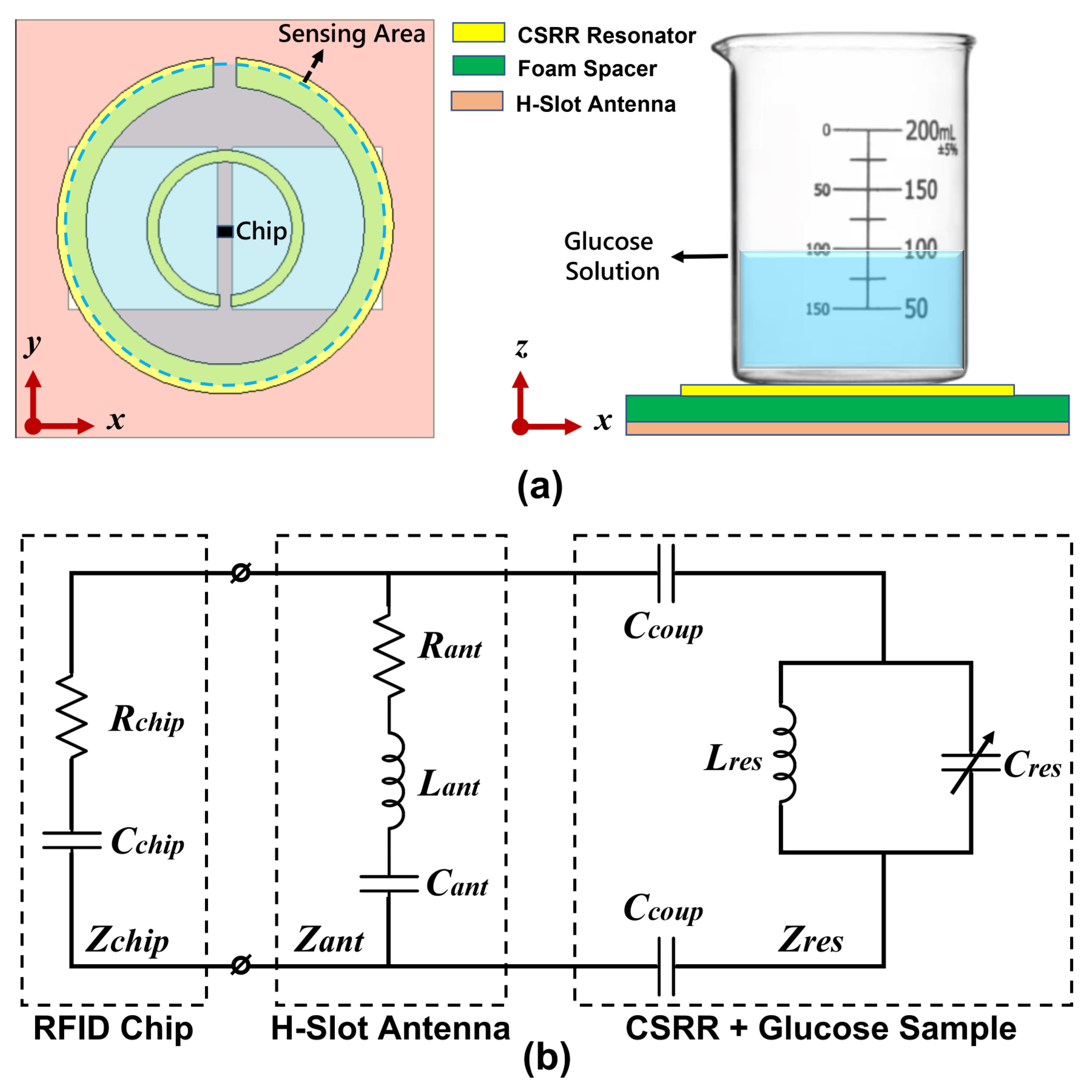

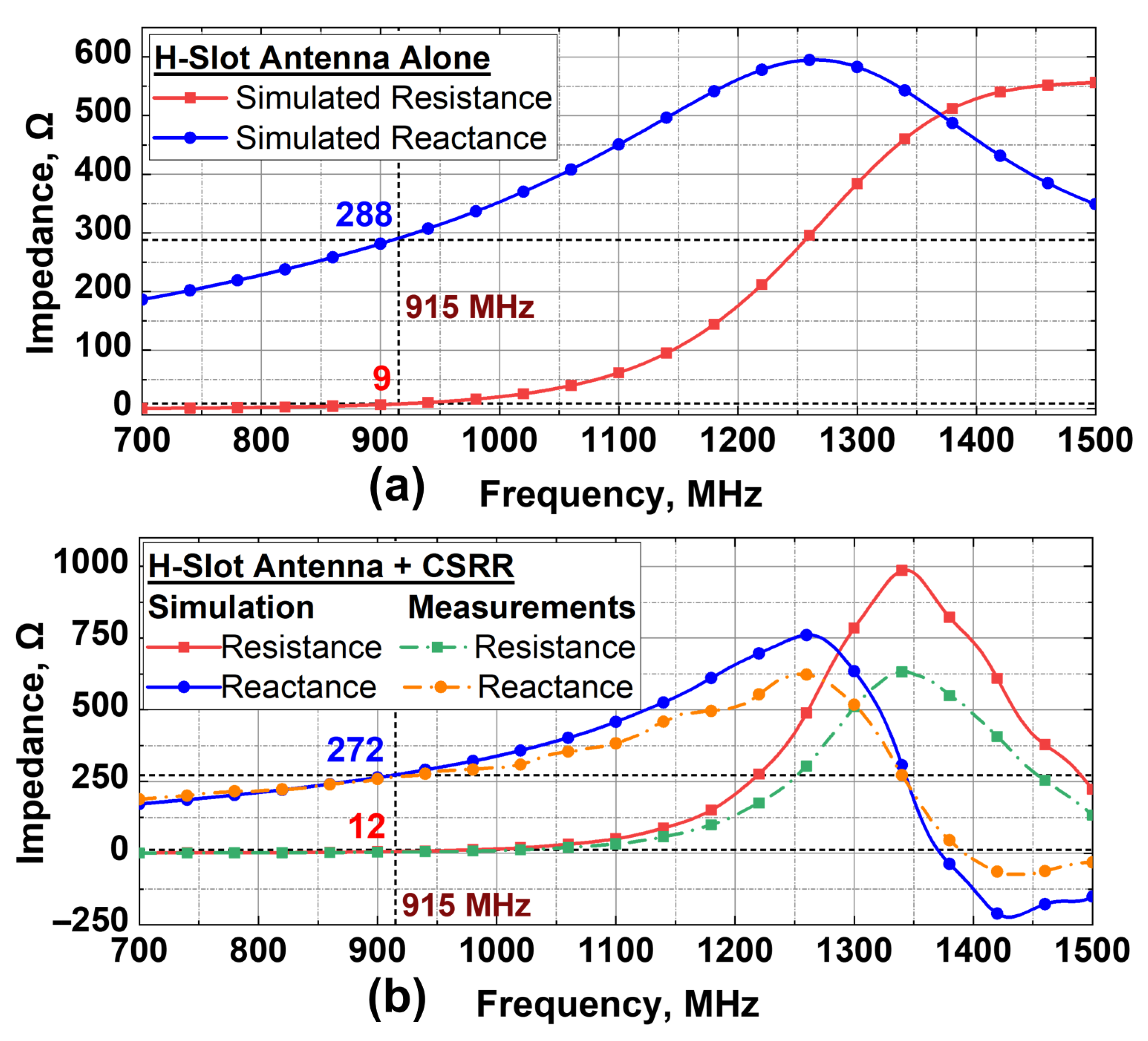

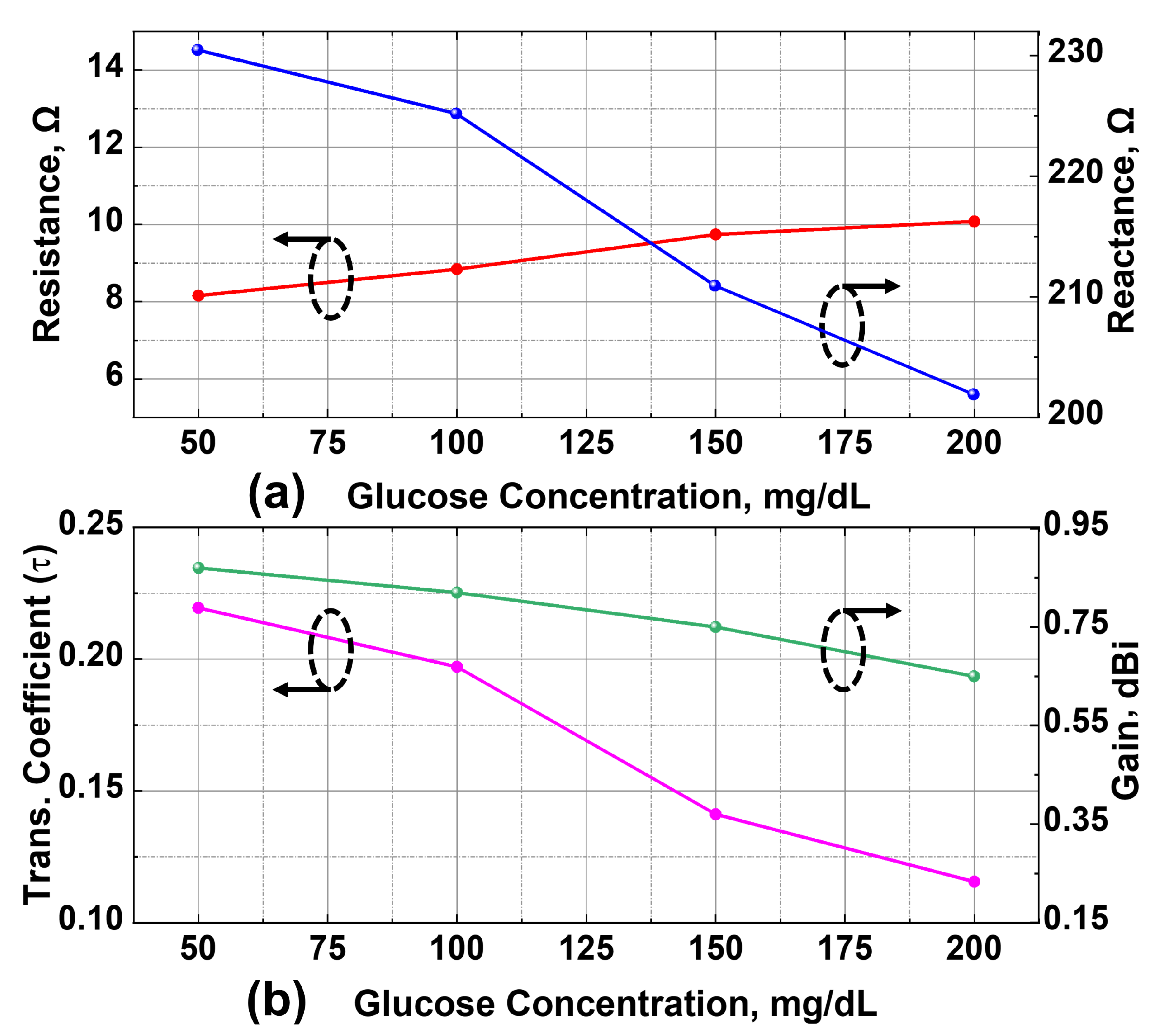
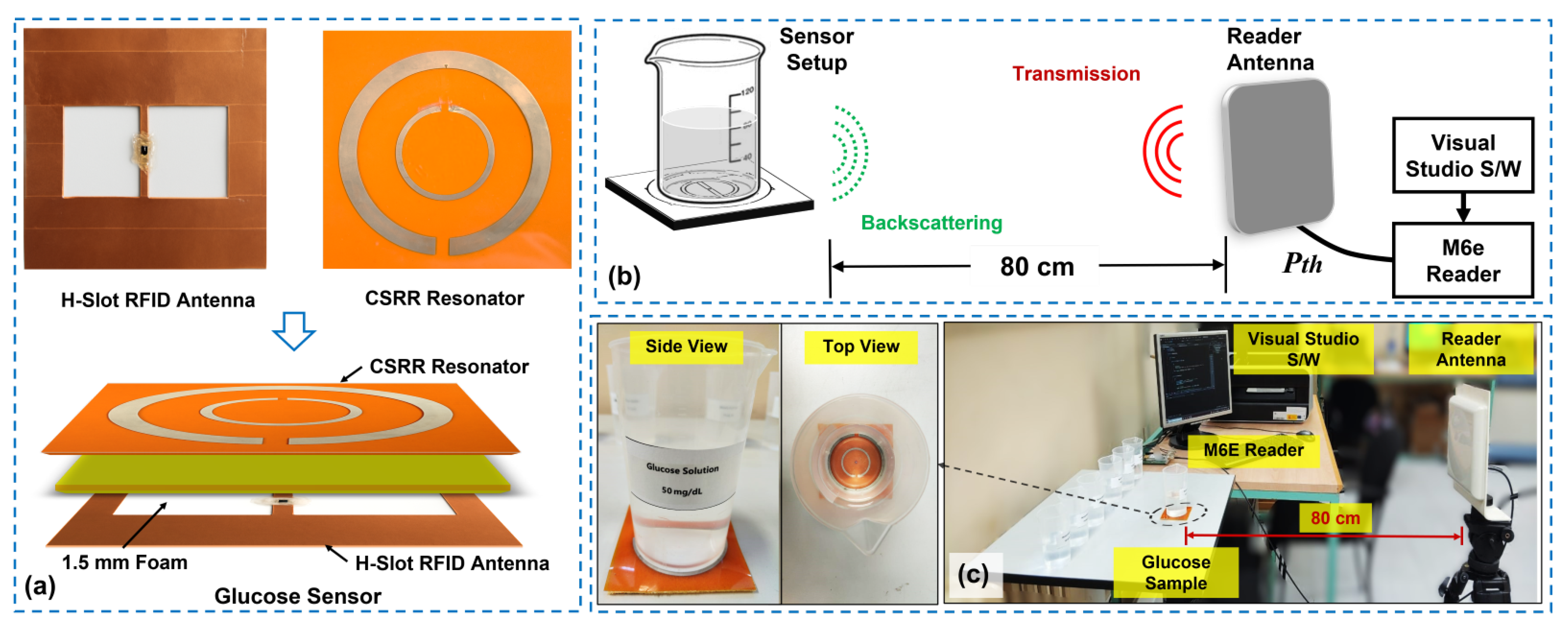
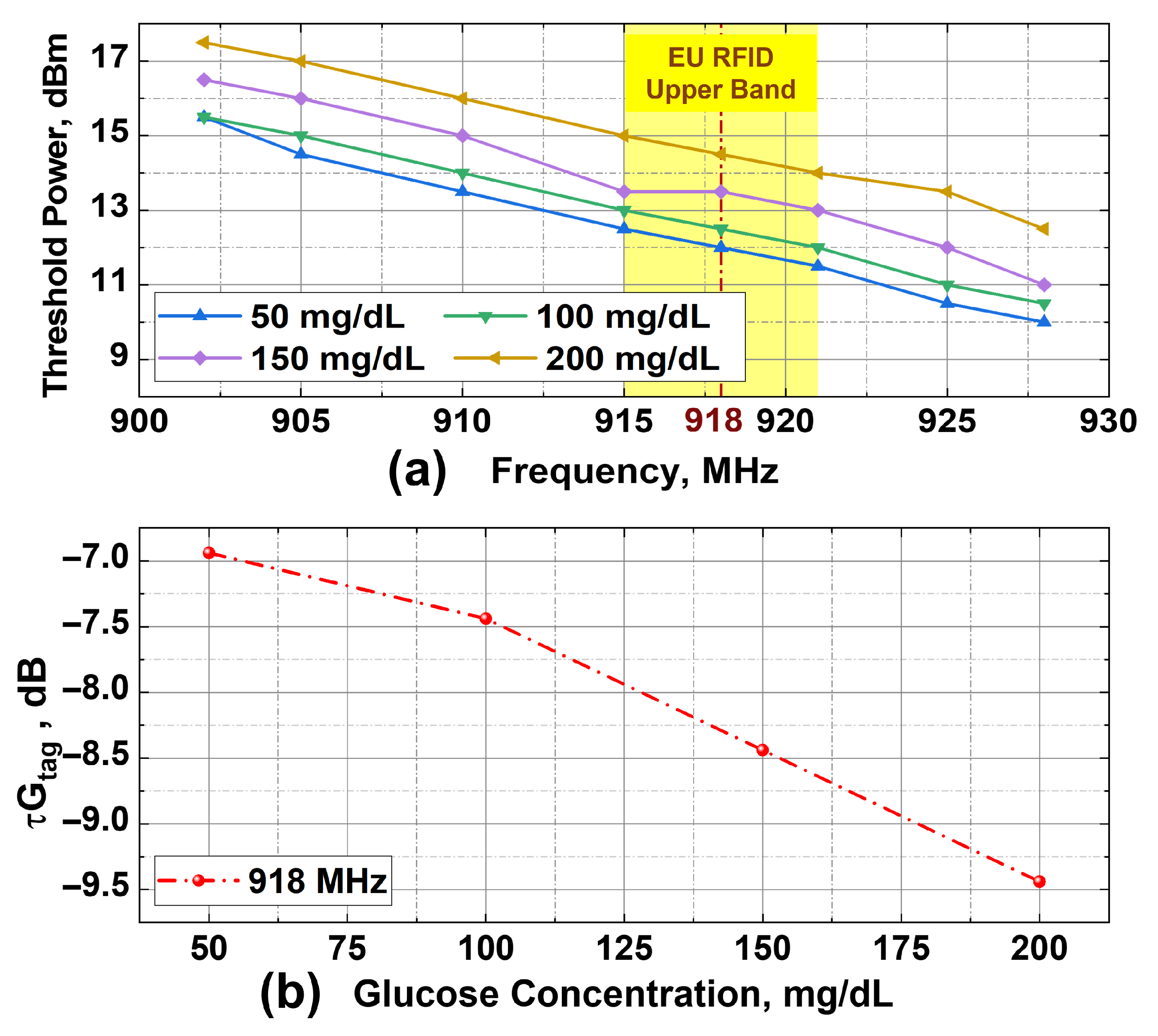
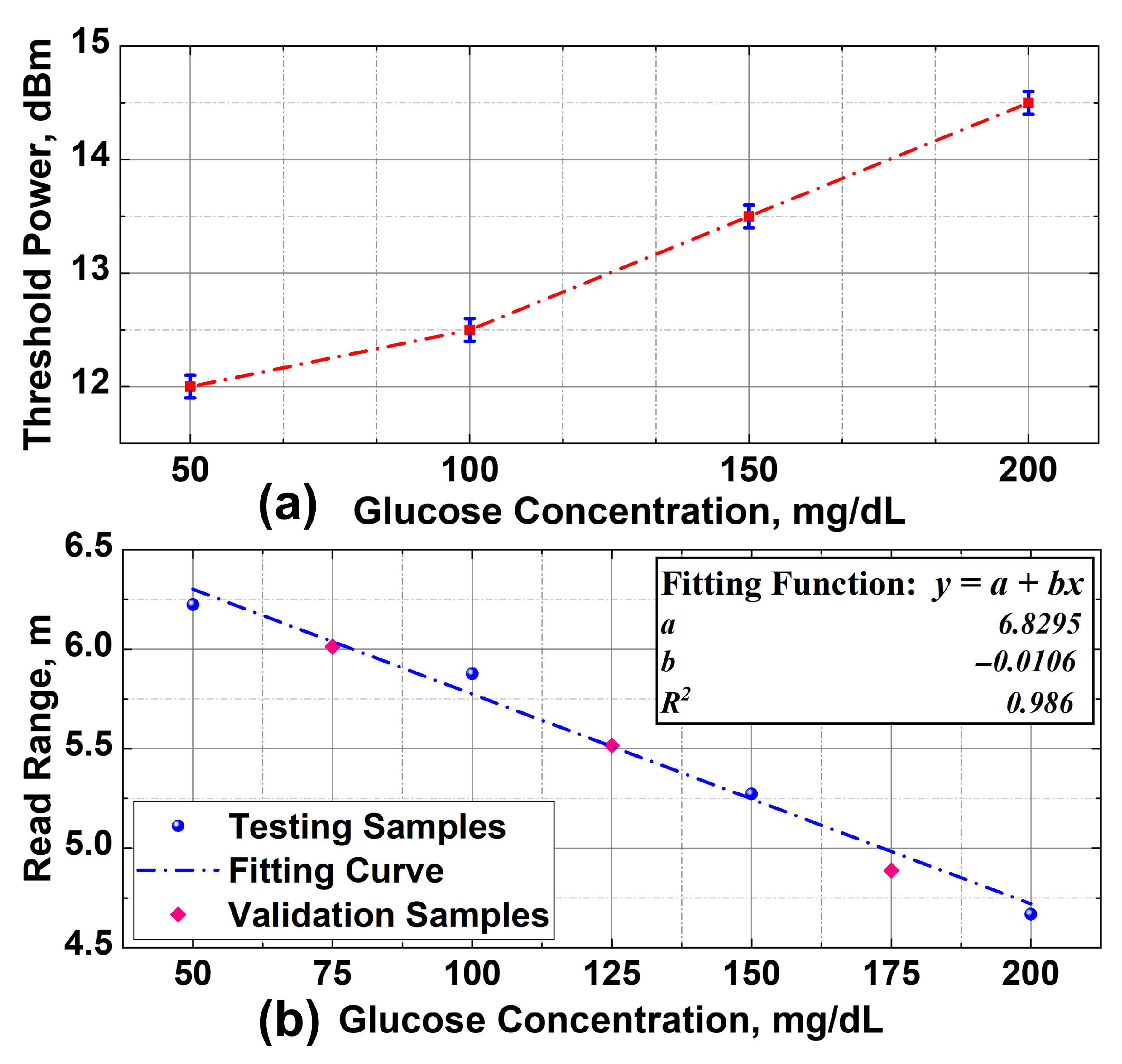
| H-Slot Antenna | CSRR Resonator | ||
|---|---|---|---|
| Parameter | Value (mm) | Parameter | Value (mm) |
| Patch length (L) | 72.3 | Inner ring radius () | 11.5 |
| Patch width (W) | 72.3 | Outer ring radius () | 23.3 |
| Slot length () | 27.0 | Inner ring gap () | 2.0 |
| Slot width () | 23.2 | Outer ring gap () | 4.0 |
| Feedline width () | 2.56 | Inner ring width () | 2.0 |
| Feed point gap () | 0.50 | Outer ring width () | 5.0 |
| Measurements | Test Concentrations (mg/dL) | Validation Concentrations (mg/dL) | |||||
|---|---|---|---|---|---|---|---|
| 50 | 100 | 150 | 200 | 75 | 125 | 175 | |
| First read power (dBm) | 12.0 | 12.5 | 13.5 | 14.4 | 12.3 | 13.0 | 14.0 |
| Second read power (dBm) | 12.1 | 12.4 | 13.4 | 14.6 | 12.4 | 13.1 | 14.1 |
| Third read power (dBm) | 11.9 | 12.6 | 13.6 | 14.5 | 12.2 | 13.0 | 14.2 |
| Fourth read power (dBm) | 12.0 | 12.5 | 13.5 | 14.5 | 12.3 | 13.1 | 14.1 |
| Average read power (dBm) | 12.0 | 12.5 | 13.5 | 14.5 | 12.3 | 13.05 | 14.1 |
| Maximum read range (m) | 6.225 | 5.877 | 5.273 | 4.668 | 6.013 | 5.516 | 4.888 |
| Read Range (m) | Validation Concentrations (mg/dL) | ||
|---|---|---|---|
| 75 | 125 | 175 | |
| Validation points | 6.013 | 5.516 | 4.888 |
| Linear fit | 6.035 | 5.505 | 4.975 |
| |Error| | 0.022 | 0.011 | 0.087 |
| Ref. | Sensor Configuration | Sensing Parameters | Measurement Equipment | Frequency (GHz) | Range (mg/dL) | Sensitivity | Portability |
|---|---|---|---|---|---|---|---|
| [22] | Circular CSRR coupled with stripline structure | VNA | 1.0–6.0 | 0–110 | 0.0345 dB/(mg/dL) | Laboratory | |
| [19] | Hexagonal CSRR with interdigital capacitor | and | VNA | 1.0–5.0 | 0–150 | 0.023 dB/(mg/dL) 1.73 MHz/(mg/dL) | Laboratory |
| [17] | Double-square CSRR (45°) with microstrip line | VNA | 1.0–4.0 | 40–500 | 0.0056 dB/(mg/dL) | Laboratory | |
| [30] | Hexagonal CSRR array with microstrip line | VNA or radar module | 2.4–2.5 | 70–120 | ≈0.94 MHz/(mg/dL) | Semi-Portable | |
| [45] | Circular CSRR as DGS with microstrip line | and | VNA | 2.0–6.0 | 0–250 | 0.0406 dB/(mg/dL) 0.117 MHz/(mg/dL) | Laboratory |
| [24] | Dual-square CSRRs with switching circuit | VNA + FG | 2.45 | 0–400 | 0.008 dB/(mg/mL) | Laboratory | |
| [11] | Square CSRR with open-ended line | and | VNA | 2.48 | 0–500 | 0.5 dB/(mg/mL) ≈1.24 MHz/(mg/mL) | Laboratory |
| [46] | Triple-pole CSRR with microstrip line | and | VNA | 1.0–6.0 | 70–120 | : 3.45 dB/(mg/dL) : 6.2 dB/(mg/dL) | Laboratory |
| [47] | CSRR-loaded T-patch antenna | VNA | 1.02–2.24 | 0–600 | 0.0016 dB/(mg/dL) | Laboratory | |
| [32] | Modified CSRR with differential SIW | DC voltages | RF generator & detectors | 1.674 | 0–300 | : 3.05 mV/(mg/dL) : 4.21 mV/(mg/dL) | Laboratory |
| This Work | Circular CSRR with H-slot UHF RFID antenna | Read range | UHF RFID reader | 0.902–0.928 | 50–200 | 1.04 cm/(mg/dL) : 6.23–4.67 m | Fully Portable |
Disclaimer/Publisher’s Note: The statements, opinions and data contained in all publications are solely those of the individual author(s) and contributor(s) and not of MDPI and/or the editor(s). MDPI and/or the editor(s) disclaim responsibility for any injury to people or property resulting from any ideas, methods, instructions or products referred to in the content. |
© 2025 by the authors. Licensee MDPI, Basel, Switzerland. This article is an open access article distributed under the terms and conditions of the Creative Commons Attribution (CC BY) license (https://creativecommons.org/licenses/by/4.0/).
Share and Cite
Hussain, T.; Abounasr, J.; Gil, I.; Fernández-García, R. Capacitively Coupled CSRR and H-Slot UHF RFID Antenna for Wireless Glucose Concentration Monitoring. Sensors 2025, 25, 5651. https://doi.org/10.3390/s25185651
Hussain T, Abounasr J, Gil I, Fernández-García R. Capacitively Coupled CSRR and H-Slot UHF RFID Antenna for Wireless Glucose Concentration Monitoring. Sensors. 2025; 25(18):5651. https://doi.org/10.3390/s25185651
Chicago/Turabian StyleHussain, Tauseef, Jamal Abounasr, Ignacio Gil, and Raúl Fernández-García. 2025. "Capacitively Coupled CSRR and H-Slot UHF RFID Antenna for Wireless Glucose Concentration Monitoring" Sensors 25, no. 18: 5651. https://doi.org/10.3390/s25185651
APA StyleHussain, T., Abounasr, J., Gil, I., & Fernández-García, R. (2025). Capacitively Coupled CSRR and H-Slot UHF RFID Antenna for Wireless Glucose Concentration Monitoring. Sensors, 25(18), 5651. https://doi.org/10.3390/s25185651









